|
Over the last 70 years, the idea of aliens from another world has become accepted by so many. Society likes the concept. Icons of this ET image are often employed as a hieroglyph of communication on social media. Just like entities from folklore of old, they are with us and incorporated into our thinking. But . . . but? Did werewolves truly exist? Did vampires? The walking dead?
Although our medieval ancestors may have believed in such things, people today, of course, believe that such ghouls are superstitious embellishments. Yet the same people today are ready to believe in aliens. Why? Because aliens are given a scientific patina. Spaceships from other planets are considered possible. Therefore occupants of those spaceships are possible. This makes aliens quite a different thing from vampires and werewolves and other denizens of October fright nights.
But as we’ve seen already at A Form of Alien, we can’t just credit the current “alien image” to Betty and Barney Hill in 1966. Over the course of dreams and hypnosis the image evolved. And from book form (The Interrupted Journey) it evolved further, and a number of factors influenced its final form. Elements of alien stories, as we saw, were already influential in the design evolution of the Betty and Barney Hill aliens, not least of which were the stories of little men from Mars.
Widespread belief that aliens exist among us obviously began with the advent of reports of flying saucers in the sky in 1947. After enough sightings, it was estimated that the largest saucers were about 100 feet in diameter, but they were also a very narrow airfoil discus, making it unlikely they were more than 20 feet thick at the center. Most saucers were thought to be around 60 feet or smaller, thus making it certain (if the reports were accurate) that the occupants were small. A small size to aliens therefore was a deduction.
The observations ongoing at White Sands Proving Grounds in New Mexico were significant. Their sightings and theodolite tracking there proved the saucers existed and were oval discs. The saucers also were capable of very fast speeds and sudden turns and swift vertical climbs. Two 20 inch discs followed a rocket launch, skimming along the rocket and even crossing through its exhaust. Then in March 1950 a very influential article was published in True magazine by one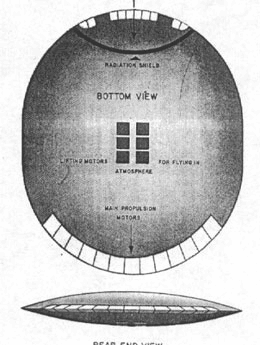 of the Navy scientists deployed there— Commander Robert McLaughlin. He noted a bee can withstand 20 Gs of force. The inference was, of course, that the occupants inside must be quite lightweight, something akin to insects. Well, it is best to quote him: of the Navy scientists deployed there— Commander Robert McLaughlin. He noted a bee can withstand 20 Gs of force. The inference was, of course, that the occupants inside must be quite lightweight, something akin to insects. Well, it is best to quote him:
“What these people look like I have no idea. Since I insist that they are actually at the controls of their strange craft, however, I must suggest that they are considerably smaller than we are. We already know that while 6 G’s are a tremendous strain on the human frame, creatures smaller than ourselves can bear up under incredible pressures. A bee can probably take 20 G’s, an ant even more. Saucer crewmen would also have to be pretty small to ride . . . the 20-inch disks. It is staggering to imagine intelligent beings that small, but we must not disregard any possibilities.”
True presented this as an accurate depiction of what they had been seeing at White Sands, New Mexico.
To some extent, McLaughlin was a bit tongue-in-cheek about the 20 inch discs having occupants. But it hit home the point that the saucer occupants on the whole were small and probably insectoid.
Flying saucers were all the rage at this point. Donald Keyhoe’s January 1950 piece The Flying Saucers Are Real in True was the most widely read magazine article in history. It was in response to this phenomenal interest that True had published McLaughlin’s article in March. Therefore his statements branched out far and wide. The theory of small, lightweight, possibly insectoid occupants, certainly made the rounds of logistic chat as well, including Pentagon water cooler chat.
There was certainly much to discuss. Rumblings of crashed saucers had been coming out of the southwest of the US. Hollywood Variety writer Frank Scully had mentioned this in a 1949 article, though citing few details and couched in somewhat tongue-in-cheek language.
However, starting on January 6, 1950, the Kansas City Star reported seriously that a saucer had crashed in the southwest USA and that the occupants were three “little men” who wore no “undergarments, but their bodies were taped.” Denver radio station advertiser, George Koehler, was one of the sources of these rumors. He supposedly had been given gadgets from a couple of the scientists involved in examining the saucer. Koehler also said the disc rotated around the dome/cabin. This was something fairly new and it reflected the most recent flying saucer reports. Arch saucer investigator Donald Keyhoe took any report of a rotating disc seriously and even flew to Denver to talk to Koehler. He walked away sure Koehler invented the hoax.
This was not the case. Koehler was just one man along a string. Rumors were still coming out of the southwest. Albuquerque FBI agent Guy Hottel heard from an Air Force investigator that 3 flying saucers had been recovered in New Mexico. On March 22, 1950, he sent off a cable to HQ in Washington. “They [the saucers] were described as being circular in shape with raised centers, approximately 50 feet in diameter. Each one was occupied by three bodies of human shape but only three feet tall, dressed in metallic cloth of a very fine texture. Each body was bandaged in a manner similar to the blackout suits used by speed fliers and test pilots.”
The accuracy of the report is not the purpose here. The point is an Air Force investigator told Hottel. The Air Force investigator’s source is not disclosed, but obviously the Air Force investigator was talking. I doubt he told Hottel alone and not his own brass. The Pentagon must have been hearing this same thing from their people in New Mexico. And undoubtedly it had been spreading through the ranks for months.
Exactly just where did this story originate? Today, no one is sure. But it didn’t start or stop with the Air Force investigator. It probably started with a couple of con men and whatever lies they were telling spread in many directions.
One direction went to Frank Scully. He expanded on the story to great success in his 1950 book Behind the Flying Saucers. The book was largely devoted to the flying saucer phenomenon of sightings and theories, but chapter 12 dealt with the story that 3 of these saucers had crashed in New Mexico and Arizona in 1948. Scully learned this from one of the scientists involved in examining them. He had “more degrees than a thermometer.” Due to his scientific status, Scully wouldn’t use his real name. He called him Doctor Gee.
Dr. Gee said that the first saucer they examined was essentially 100 feet in diameter with a central cabin set in its bottom. This cabin was 72 inches tall, 45 inches of which rose above the saucer’s disc. The cabin was 18 feet in diameter. It had portholes, and through a cracked one they gained entrance by pushing a pole through and hitting a door button. There were 16 bodies therein, the tallest being around 42 inches. They were small humans, with perfect teeth. They wore some outfit that looked like late 19th century bellhop uniforms, dark with metal buttons— an amateurish improvisation compared to what the Air Force investigator had told Hottel.
When all the loose strings are sewn together, it is obvious that a man named Silas Newton was the source of everything, including what George Koehler had repeated. From Scully’s account it is evident he had come across Newton before Koehler and before the unnamed Air Force investigator would hear the stories. This is evident in how the charming bellhop suit he reports had been upgraded to something more believable— both the AFOSI agent and Koehler had repeated the bodies were taped, though only the AF investigator put the most technical interpretation on it. The story had clearly been evolving where Newton saw it had weaknesses.
Little men from Mars or Venus had been a popular motif, and Scully’s book played into it. So even after it was exposed for its errors (Dr. Gee was actually hardware dealer Leo Gebauer, and his scientific buddy Silas Newton was a con man) the cartoon image remained of little men bug green with antennae sprouting from their heads. It was hardly believable or meant to be believable, but in 1951 Gerald Heard tried to make it believable with his book Is Another World Watching? wherein he proposed the aliens were super bees from Mars (McLaughlin had also proposed Mars was a good source).
It is legitimate to speculate, as indeed the FBI does today, that the Air Force investigator had picked up on the Gebauer/Newton scam, and this is what he reported, both to Hottel and no doubt to the Pentagon. It is possible, of course, considering Scully also came across these guys peddling their stories in the Mojave desert, supposedly while doing scientific magnetic research work. How long they had been up to this, we do not know, but the stories were being reported over late 1949 and into 1950. They also started getting more refined and believable.
Yet this explanation, though handy, does not lay to rest the ghost. Despite Gebauer and Newton being soundly debunked, the belief that saucer crashes had occurred somewhere remote persisted. Wilbert B. Smith was a Canadian electronics engineer and head for a while of a semiofficial UFO investigation in Canada. In 1961, in an interview with two Ohio UFO researchers (C.W. Fitch and George Popovich) Smith admitted that Canada had recovered about 3,000 pounds of “very strange metal” that had been recovered within a few days of July 1, 1960. “We have done a tremendous amount of work on this metal. . . .We are speculating that we have a portion of a very large device which came into this solar system. . . .we don’t know when. . . but it had been in space a long time before it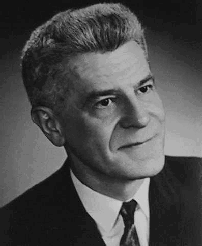 came to Earth; we can tell that by the micro-meteorites embedded in the surface.” The interview was published in 1966 by Frank Edwards in his bestseller Flying Saucers— Serious Business. came to Earth; we can tell that by the micro-meteorites embedded in the surface.” The interview was published in 1966 by Frank Edwards in his bestseller Flying Saucers— Serious Business.
Wilbert Smith, right, a cornerstone for believers.
“We don’t know if it was a few years ago or a few hundred years ago,” Smith had admitted. Thus the door was left open as to when and where this crash had occurred.
In the early 1980s, Wilbert Smith’s notes on another saucer matter came to public light. On a trip to Washington DC in September 1950 he had a talk there with Dr. Robert I. Sarbacher and learned that flying saucers did exist and the subject was the most classified secret in the US government. Astounded, Smith rushed back to his hotel and made notes. In 1983, UFO researcher William Steinman found Sarbacher was still alive and wrote to him (Smith had died in 1962). He asked him about crashed flying saucers and alien bodies.
Dr. Sarbacher finally responded to Steinman, writing back that he believed that was the case, though he had no firsthand knowledge. He recalled hearing that the materials gathered from them were of very light weight. He also wrote with certainty that John von Neuman and Vannavar Bush were involved in the recoveries and no doubt also Wernher von Braun was involved in trying to backwork the saucers.
Stunning admittance, but how much is fact and how much is derived from old Pentagon water cooler scuttlebutt? He was a “dollar-a-year-man” at Research and Development and wasn’t one of those inside. The tenor of his writing is based on what he can recall hearing or from some report he recalls he had seen. But it sounds very much like it is a combination of McLaughlin’s popular and much discussed article in 1950 and all the hooplah that went with the Gebauer/Newton scam.
Regarding the spaceships, he wrote:
“There were reports that instruments or people operating these machines were also of very light weight, sufficient to withstand the tremendous deceleration and acceleration associated with their machinery. I remember in talking with some of the people at the office that I got the impression these ‘aliens’ were constructed like certain insects we have observed on Earth, wherein because of the low mass the inertial forces involved in operating of these instruments would be quite low. . . .I still do not know why the high order of classification has been given and why the denial of the existence of these devices.”
Everything that Sarbacher wrote Steinmen reflects contemporary theory in 1950, as noted already in this article. What was significant now is that it was Sarbacher saying it, not a con man or a Variety writer. But who was influencing whom? Had the behind-the-scene scientific chat inspired those early writers like Gerald Heard or were their works inspiring the erudite chat? Which was inspiring Sarbacher’s memory?
By 1983, much had been coming to the fore in order to have influenced many old memories. Crashed saucers and recovered bodies was the new rage in saucer mania thanks to a 1980 bestseller The Roswell Incident by Charles Berlitz and William L. Moore. The popular In Search of. . . had also done an episode featuring Jesse Marcel, the USAF Major who said he recovered the remains of something strange near Roswell in 1947. He spoke with certainty that the material was tough but lightweight. He insisted he didn’t know what it was, but it was nothing he had ever seen before.
Berlitz and Moore’s book essentially used Scully’s discredited 1950 book Behind the Flying Saucers as a quick springboard, but decided to clean out the errors. They relegated Gebauer and Newton to con men but opted to believe they truly had heard something accurate and then embellished it to capitalize on it. Heavily relying on Stanton Friedman’s research, the authors then set out to find the actual witnesses who could give a more believable account. The book was a bestseller, of course, and the whole sub-genre of crashed saucers and alien autopsies remains with us.
It is only now that the aliens consistently take on the form that is still with us. Before this, spacemen were a hodgepodge of big headed creatures with bulging eyes, long claw-like hands, humpback shoulders, lopsided chests, green powdery skin, or they were robotic servo mechanisms. There were even comic moments like the big pointy-eared Kelly-Hopkinsville hobgoblins or the metallic Flatwoods Monster. As late as 1969, when The Humanoids: a survey of worldwide reports of landings of unconventional aerial objects and their alleged occupants was published there was nothing but the ridiculous mixture above for Coral Lorenzen to present in the chapter she had agreed to write on humanoid sightings in the US.
Between 1969 and 1980, the modern melon-headed alien image of Roswell took form, and its pedigree is an interesting one. And this brings us back to Betty and Barney Hill and the juncture of the Second Great UFO Flap in history.
Directly this alien image comes, of course, from Barney Hill. Although it was introduced in the page prior to this one (A Form of Alien), the case must be placed within the context at hand.
On the night of September 19/20, 1961, Betty and Barney were driving home along a remote part of Route 3 in New Hampshire. They saw a bright light pacing them along the mountains and pulled over. They got out binoculars. They saw a large UFO carrying a strange bank of lights. They pulled over a number of time on their journey south to get better vantage points. Finally, it descended and hovered just off the road ahead. It had a row of windows along the edge of the disc. A bright bluish-white light came from the interior and there were the silhouettes of figures at the windows. The disc was tilted downward, and Barney could see the figures clearly with the binoculars. Barney freaked, and rushed back to the car, where Betty had remained. He threw the binoculars in and told Betty he was sure they were going to “capture” them. They had to get the hell out of there. They sped off. A short while later they heard a series of electronic beeps and didn’t know what it was about.
They reported this incident to Pease AFB and the police. NICAP’s local investigator, Walter N. Webb, chief lecturer at the Hayden Planetarium in Boston, also went to investigate. The conservative NICAP The UFO Investigator wrote up the encounter positively in the Jan-Feb 1962 issue. This was a big deal. To get a positive pass from Donald Keyhoe’s controlled NICAP meant something. Keyhoe loathed contactee stories and stories of abductions, but believed that distant sightings of occupants could be legitimate. Betty and Barney Hill’s encounter fit. . .
. . . Until several years later. Betty was having nightmares. Barney had anxiety. They had gone over their experience in their minds so many times, puzzled by an apparent loss of two hours in their journey home to Portsmouth. In 1964, they went to a very respected psychiatrist who was also qualified in hypnosis, Dr. Benjamin Simon. Over the sessions, the abduction of Betty and Barney Hill crystalized. Under hypnosis, Barney drew a rough sketch of what the “alien” in the window looked like. While listening to the transcript of his session, he went into a trancelike state and drew a more polished version.
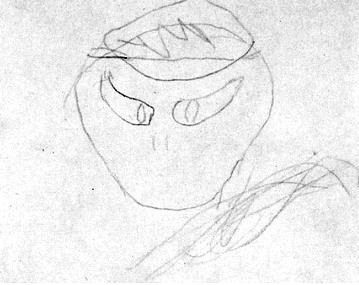 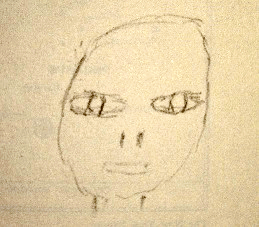
Left, the sketch done under hypnosis. Big, bug-like head. Right, the refined version. Below, later a sculptor did a bust based on Barney’s sketches.
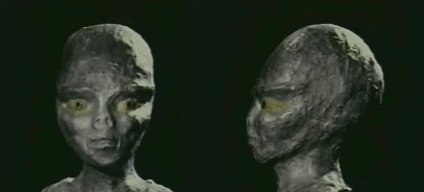
Sensational press followed the case when it went public in 1965. John Fuller’s book Incident at Exeter was soon to be published, and the Hills had agreed to let him write the book on their experience. As it stood, the conservative element of UFOlogy was all around Betty and Barney Hill. Perhaps it was time to accept abductions?
Donald Keyhoe was in an awkward position. He couldn’t denounce the incident outright like he had the others. In the Nov-Dec 1965 issue of The UFO Investigator, Keyhoe was cautious. They would await the results of Simon’s psychiatric tests to be published. Until then they would stick to the original report made in 1961, which only mentioned “humanoid” figures seen in the windows. Far from preparing to denounce the abduction as a hoax, Keyhoe speculated that the Hills’ belief in their abduction could be a psychological reaction in response to a legitimate sighting.
The response to Fuller’s book on the Hill incident, The Interrupted Journey,was enormous in 1966.
NICAP’s endorsement never came. As late as the October-September 1968 issue of The UFO Investigator, they were only starting a panel to investigate such claims. In another article, Keyhoe said he would accept the Hills’ story if a respected shrink confirmed it. He was on safe ground. He knew Simon didn’t believe in the abduction story, but rather that it came from Betty’s nightmares. Simon believed that Barney had overheard Betty talking to her sister about them, and this may have influenced his own hypnotic recall. Essentially, Simon believed there was an objective stimulus. They saw something on the road that night, but it never advanced to a tangible abduction. Obviously Coral Lorenzen, as influential in the UFO crowd as Keyhoe, also had her doubts about it being real since she did not include it in The Humanoids in 1969 (although the book’s editor Charles Bowen refers to it in another chapter as a case still under investigation which promises much).
That successful 1975 TV movie The UFO Incident would cement the Betty and Barney Hill experience into the 1970s’ conscience, a soon thereafter UFO abductions were vogue. Barney was 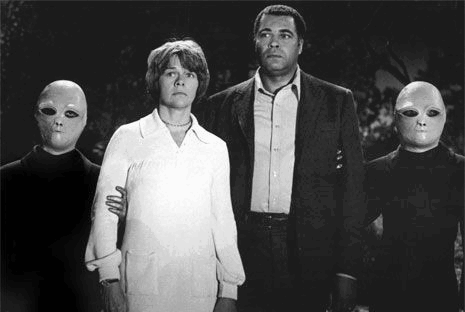 long dead now, and Betty spoke of the incident repeatedly on documentaries and at conventions. long dead now, and Betty spoke of the incident repeatedly on documentaries and at conventions.
Promos for the upcoming TV special gave us this photo. The aliens finally took form.
At the same time, Stanton Friedman, noted for being the only professional UFOlogist, and a prolific speaker, was promoting a slightly different image. In his interview for Mysteries From Beyond Earth in 1975, he sat next to a projection of such an image and declared: “This is a drawing made by an artist, a composite based on hundreds [emphasis his] of eyewitness reports— and obviously most landings don’t get reported. This character is about four and a half feet tall or so; two arms, two legs, a head and a body, slightly different facial features; obviously not like any of our friends down here on Earth.” 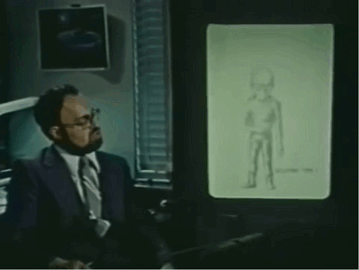
Whoever these hundreds of eyewitnesses were, they had to be squashed between 1966 and 1975, the period in which the Hill alien was influential with the UFO crowd. Friedman would likely be disposed to believe any informant at the UFO conventions who approached him with a similar description. Essentially, he opted for the image from believing in the Barney and Betty Hill story. He had met them in 1968 and investigated their claims, believing both in their tale and in the information Betty provided about a star map she had seen aboard the saucer. The excessively large head in his composite, however, seems to come from including a lot of the old 1950s and 1960s reports of big-headed comic aliens, and this distorted the “composite” image into a creature with an enormous head.
Two principle cases influential in the Friedman composite were the Antonio Villas Boas incident in October 1957 in South America, and the Valensole landing case in the south of France in 1965. The witness in Valensole said the little fellows had pumpkin-like heads, and Villas Boas described details of his sexual 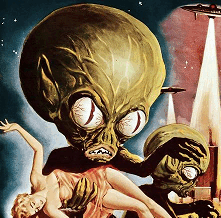 encounter in South America with a large headed and narrow chinned seductress. Both cases were prominently featured in The Humanoids. But a critical look at both cases really does not link the alien descriptions to what Barney Hill described. Rather there’s a lot of popular contemporary SCI-FI in them, as there is in Friedman’s convention hall composite. encounter in South America with a large headed and narrow chinned seductress. Both cases were prominently featured in The Humanoids. But a critical look at both cases really does not link the alien descriptions to what Barney Hill described. Rather there’s a lot of popular contemporary SCI-FI in them, as there is in Friedman’s convention hall composite.
Left, Invasion of the Saucer Men was a cheesy but popular 1957 SCI-FI driller. It seems to have inspired Friedman’s composite the most.
The factor that would become the most influential in creating and maintaining the modern image of the Hill alien is the belief that alien saucers have crashed and the dead bodies of their occupants, identical to the Hills’ grays, have been seen by numerous witnesses at the crash scenes, while in canisters during transshipping, and at their final resting place, a restricted lab facilities at an Air Force base.
The whole genre of crashed saucers and alien bodies was nonexistent until October 1974 when Robert Spencer Carr, a retired mass communications teacher at U of South Florida, declared that 12 alien bodies existed in deep freeze in Hangar 18 at Wright-Patterson AFB. So too, he said, was an alien saucer, which he asserted had crashed in 1948. It was Scully’s story redux. . .except for mentioning the base and Hangar 18. Scully had never mentioned either. After the enormous publicity he received, a few people who claimed to have worked at the base came forward and corroborated the story.
It is likely that low grade rumors of bodies and saucers did surround Wright-Patterson. This being the case, Carr was probably led to his beliefs from having picked up on these rumors. His only point of reference to explain these rumors was Scully’s old book. During his lectures and radio gigs he simply used Scully’s book to fill in the many large blank 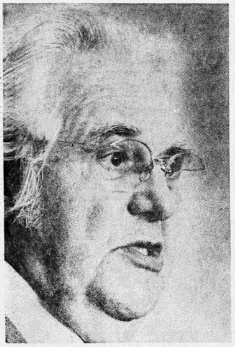 spots in the current story that culminated in the mystery of Hangar 18. It was a tragic mistake which eventually undermined Carr’s credibility. spots in the current story that culminated in the mystery of Hangar 18. It was a tragic mistake which eventually undermined Carr’s credibility.
Whisked away into obscurity by UFOlogy, the elderly Robert Carr nevertheless is the father of the genre of alien autopsies and crashed saucers. His association of the stories surrounding Hangar 18 and Wright-Patterson with Scully’s book was an embarrassment. He was a member of conservative NICAP.
As a full time saucer investigator, Stanton Friedman nevertheless saw the value in the concept. But like many others in the UFO field he knew there was little credibility to Scully’s old story. However, he had long believed in government coverups. He also now felt he had a better lead than Carr’s rumors. He had been tipped off to this lead by UFO addict Len Stringfield.
Based in Cincinnati, relatively close to Dayton and Wright-Patterson AFB, Stringfield was one of the longest lasting heavyweights in UFO research, going back to practically the beginning of the phenomenon. Over the last few years, set in earnest by Carr’s sensational news coverage, he had been compiling reports of crashed and recovered alien discs which then coalesced into his special paper Retrievals of the Third Kind (1978) and later a series of articles in Flying Saucer Review (July 1979) with the same title. Among the many abstracts recounting some very intriguing stories of alien bodies in deep freeze, there is by comparison a rather dull case. It is of an old retrieval of nothing more than hard though light fragments from Roswell in 1947. His source was a “Major J.M. in Houma, Louisiana.” This was the tip.
Len Stringfield’s work carried a lot of weight on the subject of crashes and recoveries. And Stan Friedman liked to do research. Out of all the cases Stringfield had compiled (based on supposed eyewitnesses whose names he protected with their initials or aliases) Friedman knew only one case had ever made contemporary waves— Roswell. Thus it was potentially the only case that could lead to a date and time and place. And Stringfield had essentially published the link— Major J.M. Speaking direct with Major J.M., who was actually Major Jesse Marcel, the intelligence officer mentioned in the old newspaper reports in July 1947, Friedman had found an adamant and respectable source insisting the stuff he picked up wasn’t of this Earth. This made Marcel a solid witness that the material must lead to a flying saucer. Friedman set out to prove the alien connection to the fragments Marcel had picked up. He was very influential in the making of the 1979 UFOs Are Real. This is the first nationally aired documentary in which Jesse Marcel would appear and discuss the Roswell crash. What had been a complete no-start in Stringfield’s dossier was becoming the most intriguing event in UFO history.
Within Stringfield’s dossier, there was a description of a recovered alien body. Stringfield drew the sketch as described to him and published it in his paper and in the articles in Flying Saucer Review. 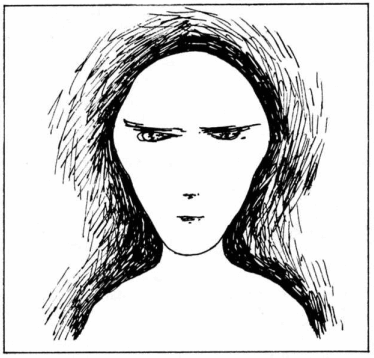 Berlitz/Moore reproduce Stringfield’s sketch. It is very suggestive of the Hill alien. Now we are given the link between Betty and Barney Hill’s aliens and Roswell. Berlitz/Moore reproduce Stringfield’s sketch. It is very suggestive of the Hill alien. Now we are given the link between Betty and Barney Hill’s aliens and Roswell.
Leonard Stringfield’s sketch of a dead alien at Wright-Patterson AFB, as related to him by an eyewitness. Stringfield was very influential behind-the-scenes in UFOlogy, but J. Allen Hynek would find him frustrating in how he wouldn’t divulge his sources.
Ironically, however, the sketch had nothing to do with Roswell. Stringfield had given the Roswell report little play in his Retrievals since it was the report of nothing more than strong, lightweight fragments. There was no saucer, no bodies, so no real retrieval of a third kind. The sketch apparently came from witnesses of the bodies at Wright-Patterson AFB in Ohio and were connected to no specific crash in Stringfield’s heavy arsenal of reports, most of which were actually dated to the early 1950s.
Consistent alien descriptions that match the Betty and Barney Hill grays really seem to come through Friedman and Stringfield after 1975 and not through hundreds of eyewitnesses of unreported saucer landings. This seems quite certain from the work of Fred Merritt (A Preliminary Classification of Some Reports of Unidentified Flying Objects Based on Shape and Dimensions of Imprint Patterns) which J. Allen Hynek’s CUFOS (Center For UFO Studies) published in 1976. Merritt writes:
Physical trace reports are relatively rare in the UFO literature.
Specialist Ted Phillips has published a catalog of 833 physical
trace reports. Reports specifying imprints, which are often taken
to be marks left by landing gear, are even less common. UFOCAT,
Dr. David R. Saunders’ computer file of some 80,000 UFO reports, is
aware of only 110 imprint cases. . .
Friedman could not possibly have had hundreds of eyewitnesses of alien landings by 1975. Ted Phillips was the go-to man for UFO landings. As Merritt notes, he had 833 cases of physical traces, but most of these traces were radiation, dry soil, wilted grass, etc., and not reports of alien beings. Hynek’s CUFOS had also published Phillips’ Physical Traces Associated with UFO Sightings in 1975, and descriptions of aliens therein is largely the result of Phillips reading popular UFO fan journals since the early days. In addition, Robert Fuller compiled Ted Phillips’ Trace Catalog and it was published in Crop Watcher, for those who followed the Crop Circle phenomenon. Neither contains any consistent alien image, even for the footprints. They are amorphous indents, wedges, etc.
It is actually Stringfield’s Retrievals and Friedman’s assertions about Roswell that confirm for us the alien gray image of the smashing 1975 The UFO Incident. Also, this movie seems to be what influenced “eyewitnesses” thereafter. Ted Phillips suddenly uncovered consistency in the burgeoning reports of alien landings. In the 1979 documentary UFOs Are Real he makes a rare appearance and states: “You find a surprising number of incidents where humanoids are reported near the landed UFO. Some 22% or 325 cases involve humanoids, generally described as small in size, kinda pale gray skin, little if any hair, wide set quite prominent eyes, thin, spindly bodies, slightly large heads, and wearing tight fitting diver’s suit, as it is generally described. In over 50 cases there were found small footprints correlating, of course, with the small humanoids seen.”
What Phillips is now describing is the Betty and Barney Hill alien, somewhat tailored and tinkered with in UFOlogists’ hands (Betty and Barney initially said they had broad chests). Phillips assessment is not a reassuring statement. Along with the new, he seems he had come to interpret all the old “eyewitness” sightings with the poplar Betty and Barney Hill alien motif. The reason? This image had become powerful in the intellectually incestuous UFO crowd because no less than Stan Friedman could “confirm” a UFO crash at Roswell and Len Stringfield could say there were bodies at Wright-Patterson (though his sources never associated it with Roswell but with the early 1950s) that matched the Hill alien. On top of this, Stringfield could present his sketch of what these bodies in deep Air Force freeze looked like. Phillips certainly saw it and signed a rather contradictory affidavit to that fact (reproduced by Berlitz and Moore in The Roswell Incident). All combined, this obviously seemed weightier than the Hill hypnosis session and may have inspired Phillips to codify all the sightings into uniformity.
Despite the minor tinkering, the Roswell alien as drawn by Stringfield, summarized by Phillips, and presented by Berlitz and Moore, is the Hill alien. In fact, it is safe to say all the reports of alien corpses and their affinity to the Barney Hill alien date after 1975 and are inspired by the Hill alien image as presented in the primetime success The UFO Incident.
The evolution of the Betty and Barney Hill alien is a complex story. More details are at A Form of Alien. Here, with the above, the hunting dog basically has the scent. A number of documentaries would expand on this alien image, and Stanton Friedman’s reconstruction of such an alien with a distorted large head would prove significant. He was the only professional UFOlogist and he devoted all his time to the subject. His popularity at the conferences would prove more influential when it came to media promotional artwork and TV shows. Slowly but surely, the little gray with the enormous melon head 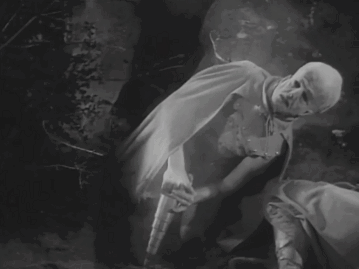 would be the alien image. would be the alien image.
Nevertheless, everything really sprouts from Barney Hill’s sketches. As such, we are not on solid ground. It is, in fact, incredibly disturbing that the alien image has come to reflect our own long-standing comic strip and movie SCI-FI image.
Right, Flash Gordon’s Trip to Mars, 1938— bald, big headed aliens are a SCI-FI staple.
Stanton Friedman was an essential conduit of the alien image to us because he took it from being nothing but Barney Hill’s hypnosis sketch and said “hundreds” others had seen the actual bodies or living critters around the landed objects. But he was essentially refining Barney Hill’s sketch. He made no secret he believed in the Hill encounter. He believed in the Roswell Incident and in Stringfield’s sketch that matched the Hill alien. Aliens were born. Betty and Barney Hill were the parents and Stanton Friedman the midwife. Stringfield was the Godfather. Berlitz and Moore announced the birth in their bestseller The Roswell Incident and thereafter the genre has delighted us, expanded to more crashes and more bodies. . . but that is for another page— Roswell.
I am not mocking nor am I debunking the alien image. I am establishing. This is where it comes from. It doesn’t have a great pedigree. Nor is it really aboveboard. Few credible eyewitnesses spoke contemporarily of their Close Encounters of the Second Kind. Of these witnesses we have nothing from Father Gill and his parishioners but the outline of 4 people waving back at them. From Barney Hill we have the visual (through binoculars) of “figures” standing in the windows. He was high strung at the best of times and wasn’t likely to wave at them, so they weren’t likely to wave back. He didn’t give detailed form to these figures until a few years later, and it really didn’t come through the most reliable conduit.
Before we take and follow the straight path from the past to the present, and avoid the juncture of 1965-1967, we must go back, back to Roswell and the beginning.
|